Research on Grouting Pressure of Earth–Rock Dams Reinforced by Polymer Based on Discrete Elements
Abstract
Featured Application
Abstract
1. Introduction
2. PFA-Reinforced Rockfill Materials Technology
2.1. Technical Principles
2.2. Construction Process
- Preparation of polymer cementitious materials: The polymer cementitious material is primarily divided into two parts. Before grouting, it is blended and subjected to tests for density, viscosity, gel time, coagulation time, foaming rate, and compressive strength to determine the optimal material ratio.
- Preparation before grouting: Per the seismic design requirements of earth–rock dams, seismic reinforcement measures are implemented for rockfill materials in the upper portion of the dam body (within the dam height range of 3/4~4/5). For new earth–rock dams, polymer grouting reinforcement is conducted concurrently with the layer-wise filling of the dam body. To minimize construction period disruption, reinforcement construction and dam filling construction are carried out separately in different areas. For earthquake-damaged earth–rock dams, visual inspection, leveling measurement, core drilling, and ultrasonic tomography are utilized to identify dam cracks, subsidence, and landslide instability.
- Grouting hole setting: Before excavating grouting holes, the construction site is cleaned to ensure debris-free, clean positions for the holes. For new earth–rock dams, grouting holes are arranged in square or triangular patterns, with adjacent filling layer holes staggered. Hole spacing within each layer is set at 4 m, with a minimum hole diameter of 40 mm. Hole depth should be a multiple of the filling height of each layer, with specific construction adjusted based on actual conditions. For earthquake-damaged earth–rock dams, adjustments are made based on the location, extent, and slurry diffusion radius of the damage.
- Grouting: Necessary polymer and grouting equipment is prepared, and grouting pipes are inserted into boreholes, ensuring tight connection with equipment pre-loaded with mixed polymer. Grouting is conducted by injecting the material components into the holes under pressure. Grouting duration is determined by porosity and slurry diffusion radius. Grouting ceases upon reaching the preset time, ensuring each hole is grouted in one session.
- Hole detection and sealing post-grouting: Upon completion of grouting, grouting effectiveness is assessed via coring. Once testing confirms satisfactory results, holes are sealed with thin mortar or a protective coating layer.
3. Principle of Fluid–Solid Coupling Model
3.1. Mathematical Model of Polymers
- Rheological property
- 2.
- Viscosity
- 3.
- Thermal conductivity.
3.2. Fluid–Solid Coupled Model
4. Establishment of Fluid–Solid Coupling Model
4.1. Simulation Method
4.1.1. Rockfill Materials Accumulation Part
4.1.2. Fluid–Solid Coupling Part
4.2. Calculation Scheme
- Model Box and Particle Generation: The model box uses boundary particles instead of boundaries to limit the particles within the model, apply boundary conditions, and construct the fluid domain. The thickness is, by default, two average unit particles. All degrees of freedom of the left boundary, right boundary, and lower boundary particles of the model box are constrained to simulate the real state of the model box. Subsequently, surrounding pressure is applied to the upper boundary to simulate the rolling process of rockfill materials. In the discrete element numerical simulation of the rockfill body, it is crucial to select an appropriate particle size range, as the minimum stable time step decreases significantly with smaller particle sizes. For this simulation, a model box measuring 1000 mm × 600 mm was created. The average particle size is set at 5 mm, with a particle diameter dispersion coefficient of 9, leading to a maximum particle size of 9 mm and a minimum of 0.09 mm. A total of 6581 rockfill particles were generated, with fine particle content under 5%, a non-uniformity coefficient (Cu) of 18.75, and a curvature coefficient (Cc) of 2.3, classifying the gravel as well-graded (GW). The gradation curve of the rockfill material is depicted in Figure 5.
- 2.
- Compaction Deposition Process: To achieve a random distribution of particle units within the simulation box, particles are initially subjected to random velocities before the compaction process to ensure a natural layout. Subsequently, gravity is applied, allowing the particles to naturally accumulate under its influence. Finally, 10 periods of gravity compaction were carried out to complete the whole compaction deposition process and ensure the close accumulation of particle units.
- 3.
- Preparation for Simulation: before assigning material parameters, the model’s unit gravity is incrementally reduced, divided by 10 in each step, and the system is balanced 200 times, followed by an additional balance, before finally saving the model data (Figure 6).
- 4.
- Creation of the Grouting Hole: Post-import of the basic accumulation model data, coordinates of rockfill particles are documented. Particles within specified ranges (mZ > 0.4 m, 0.48 m < mX < 0.52 m) are filtered and removed to establish a grouting hole measuring 40 mm in diameter and 15 mm in depth. Subsequently, material parameters are set for the rockfill model, and the ‘breakGroup’ function is employed to sever all particle connections, rendering the model a granular body. The ‘addFixId’ function is then utilized to filter and secure particles within a specific range, simulating the section of the grouting pipe inserted into the grouting hole. Model data are then saved (Figure 7).
- 5.
- Polymer Grouting Simulation: Inside the grouting hole, polymer grouting simulation is initiated with the polymer set at a density of 1000 kg/m3 and a viscosity of 0.9 Pa·s. The area is subjected to a consistent grouting pressure of approximately 1 MPa. The model’s computational timestep is set at 1 × 10−6 s, with each cycle iterating 1000 times. The loading cycle is 0.001 s, repeated ten times, totaling a simulation time of 0.01 s. Based on the principle of similarity, a real-time grouting period of approximately 10 s is simulated by scaling 0.01 s by a factor of 1000 to achieve 10 s.
5. Feasibility Verification of the Model
- Stress–strain characteristics: utilizing parameters from an indoor static triaxial test [13] (Table 2), we examined the stress–strain curves of rockfill materials before and after adding polymers under 100 kPa confining pressure, compared the simulation results with the results of indoor tests, and verified the rationality of the model. (Figure 8).
- 2.
- Slurry diffusion form and scope: Because there is no polymer direct grouting rockfill materials test, the simulation was carried out according to the parameters of an indoor polymer grouting transparent soil test [20] (Table 3). The slurry diffusion range and slurry diffusion form obtained by the model were compared with the test results to verify the rationality of fluid–solid coupling (Figure 9 and Figure 10).
6. Simulation Result Analysis
6.1. Analysis of Slurry Diffusion Morphology
- At 1 s, the slurry predominantly gathers near the grouting hole, forming a nascent “U” shape. Initially, under the influence of grouting pressure, the slurry fills the grouting hole and adjacent voids. At this stage, diffusion is restricted, primarily influenced by the grouting hole diameter and pressure.
- Between 2 and 6 s, as grouting progresses, the slurry diffusion range rapidly expands, creating a pronounced “U” shape. This expansion suggests an acceleration in the slurry’s diffusion rate within the rockfill body. In the X direction, diffusion is notably more extensive near the surface, likely due to the looser structure and higher porosity at the surface, which facilitate easier slurry movement.
- From 7 to 10 s, in the later stages of grouting, the rate of slurry diffusion gradually decreases and eventually stabilizes. This deceleration indicates that the available voids within the rockfill are becoming filled, limiting further diffusion. Nonetheless, the inherent permeability and diffusivity of polymer foam allow it to maintain a consistent diffusion rate even as the process nears completion.
6.2. Influence of Different Grouting Pressures
6.2.1. Variation of Slurry Diffusion Range
6.2.2. Changes in Overall Porosity
6.2.3. The Change in Regional Porosity
6.2.4. Stress Changes Before and After Grouting
- At a grouting pressure of 0.1 MPa, stress increases by 3.42% in the X direction and 3.73% in the Z direction.
- At 0.3 MPa, the increases are 5.90% and 6.69% in the X and Z directions, respectively.
- At 0.5 MPa, these values rise to 8.50% and 9.27%.
- At 0.7 MPa, stress increases to 10.48% in the X direction and 10.89% in the Z direction.
- Finally, at 0.9 MPa, the increases are 12.59% and 12.13%, respectively.
7. Conclusions
- The diffusion of polymer foam within the rockfill body progresses through three distinct stages: the initial slurry is concentrated near the grouting hole, then diffuses rapidly, and finally, the diffusion rate slows down and tends to be stable. During the intermediate phase of grouting, the relatively loose structure and higher porosity of the rockfill surface facilitate easier diffusion of the grout. As grouting progresses to the later stages, the voids available for grout diffusion within the rockfill gradually diminish, imposing certain limitations on the spread of the grout. However, due to the excellent permeability and diffusivity of polymeric foam, a consistent rate of diffusion can still be maintained. This progression exhibits the characteristic features of seepage grouting in polymer foams, aligning with established seepage grouting theories and aiding in understanding the polymer diffusion dynamics within rockfill structures. In practical engineering applications, it is essential to select grouting materials judiciously based on the specific conditions of the rockfill and the reinforcement requirements to achieve optimal grouting and consolidation outcomes;
- Variations in grouting pressure significantly influence the diffusion extent of the slurry. At low pressures, the diffusion range noticeably increases with rising pressure. The range stabilizes under medium pressure and changes minimally at high pressures. Additionally, the vertical (Z-axis) diffusion consistently exceeds the horizontal (X-axis) diffusion, with the former being more responsive to changes in grouting pressure;
- There is a direct correlation between grouting pressure and porosity reduction. As grouting pressure increases, the porosity decrease becomes more pronounced, suggesting that higher pressures more effectively compel the slurry to occupy finer pores, thus enhancing material compactness. Across different regions, increasing grouting pressure typically reduces porosity, with the reduction diminishing with distance from the grouting point. At a grouting pressure of 0.9 MPa, the decrease in porosity in regions X2 and X3 is less pronounced, indicating a more uniform polymer distribution and limited pressure influence;
- The relationship between stress increase and grouting pressure is approximately linear. Both the X and Z directional stresses rise with increasing grouting pressure, exhibiting a linear trend. However, the rate of increase differs between directions, with stress in the Z direction slightly surpassing that in the X direction at lower pressures, and vice versa at higher pressures.
Author Contributions
Funding
Institutional Review Board Statement
Informed Consent Statement
Data Availability Statement
Acknowledgments
Conflicts of Interest
References
- Kong, X.; Zhu, T.; Han, G. Effects of measures for enhancing dynamic stability of concrete-faced rockfill dam. J. Jpn. Soc. Dam Eng. 2000, 10, 93–101. [Google Scholar] [CrossRef]
- Liu, J.; Liu, F.; Kong, X.; Yu, L. Large-scale shaking table model tests of aseismic measures for concrete faced rock-fill dams. Soil Dyn. Earthq. Eng. 2014, 61, 152–163. [Google Scholar] [CrossRef]
- Liu, H.L.; Fei, K.; Yang, G.; Liu, P. Use of polyurethane foam adhesive-reinforced rockfill material to improve seismic behavior of earth-rockfill dam. Adv Sci Technol Water Resour. 2016, 36, 60–65+70. (In Chinese) [Google Scholar]
- Bodi, J.; Bodi, Z.; Scucka, J.; Martinec, P. Polyurethane Grouting Technologies; Croatia INTECH Open Access Publisher: Rijeka, Croatia, 2012. [Google Scholar]
- Fang, H.; Su, Y.; Du, X.; Wang, F.; Li, B. Experimental and numerical investigation on repairing effect of polymer grouting for settlement of high-speed railway unballasted track. Appl. Sci. 2019, 9, 4496. [Google Scholar] [CrossRef]
- Liu, P.; Liu, H.L.; Yang, X.; Gui, Y. Experimental research on mechanical properties of PFA-reinforced rockfill materials. Rock Soil Mech. 2015, 36, 749–754. (In Chinese) [Google Scholar]
- Xiao, Y.; Liu, H.; Desai, C.S. New method for improvement of rockfill material with polyurethane foam adhesive. J. Geotech. Geoenvironmental Eng. 2015, 141, 02814003. [Google Scholar] [CrossRef]
- Liu, H.L.; Liu, P.; Yang, G. Experimental investigations on dynamic residual deformation behaviors of PFA-reinforced rockfill materials. Rock Soil Mech 2017, 38, 1863–1868+1886. (In Chinese) [Google Scholar]
- Hao, M.; Wang, F.; Li, X.; Zhang, B.; Zhong, Y. Numerical and experimental studies of diffusion law of grouting with expansible polymer. J. Mater. Civ. Eng. 2018, 30, 04017290. [Google Scholar] [CrossRef]
- Liang, J.; Du, X.; Fang, H.; Li, B.; Zhao, X.; Xue, B.; Zhai, K.; Wang, S. Numerical manifold simulation and medium-parameter analysis of the polymer grouting process in three-dimensional rock fractures. Comput. Geotech. 2024, 169, 106191. [Google Scholar] [CrossRef]
- Zhu, Y.; Wang, X.; Deng, S.; Chen, W.; Shi, Z.; Xue, L.; Lv, M. Grouting process simulation based on 3D fracture network considering fluid-structure interaction. Appl. Sci. 2019, 9, 667. [Google Scholar] [CrossRef]
- Kamal, I.; Bas, Y. Materials and technologies in road pavements-an overview. Mater. Today Proc. 2021, 42, 2660–2667. [Google Scholar] [CrossRef]
- Liu, P. Experimental Study on Static and Dynamic Characteristics of PFA-Reinforced Rockfill Materials and Seismic Evaluation on its Application on High Earth Rockfill Dam. Ph.D. Thesis, Hohai University, Nanjing, China, 2015. (In Chinese). [Google Scholar]
- Seo, D.; Youn, J.R. Numerical analysis on reaction injection molding of polyurethane foam by using a finite volume method. Polymer 2005, 46, 6482–6493. [Google Scholar] [CrossRef]
- Castro, J.M.; Macosko, C.W. Studies of mold filling and curing in the reaction injection molding process. AIChE J. 1982, 28, 250–260. [Google Scholar] [CrossRef]
- Rojas, A.J.; Marciano, J.H.; Williams, R.J. Rigid polyurethane foams: A model of the foaming process. Polym. Eng. Sci. 1982, 22, 840–844. [Google Scholar] [CrossRef]
- Hardy, S.; Finch, E. Discrete element modeling of the influence of cover strength on basement-involved fault-propagation folding. Tectonophysics 2006, 415, 225–238. [Google Scholar] [CrossRef]
- Hardy, S.; McClay, K.; Muñoz, J.A. Deformation and fault activity in space and time in high-resolution numerical models of doubly vergent thrust wedges. Mar. Pet. Geol. 2009, 26, 232–248. [Google Scholar] [CrossRef]
- Zhu, Y.; Liu, C.; Liu, H.; Kou, Y.-D.; Shi, B. A multi-field and fluid-solid coupling method for porous media based on DEM-PNM. Comput. Geotech. 2023, 154, 105118. [Google Scholar] [CrossRef]
- Gao, Y. Experimental Investigations on the Mechanisms of Chemical Grouting in Transparent Soil. Ph.D. Thesis, China University of Mining and Technology, Xuzhou, China, 2016. (In Chinese). [Google Scholar]
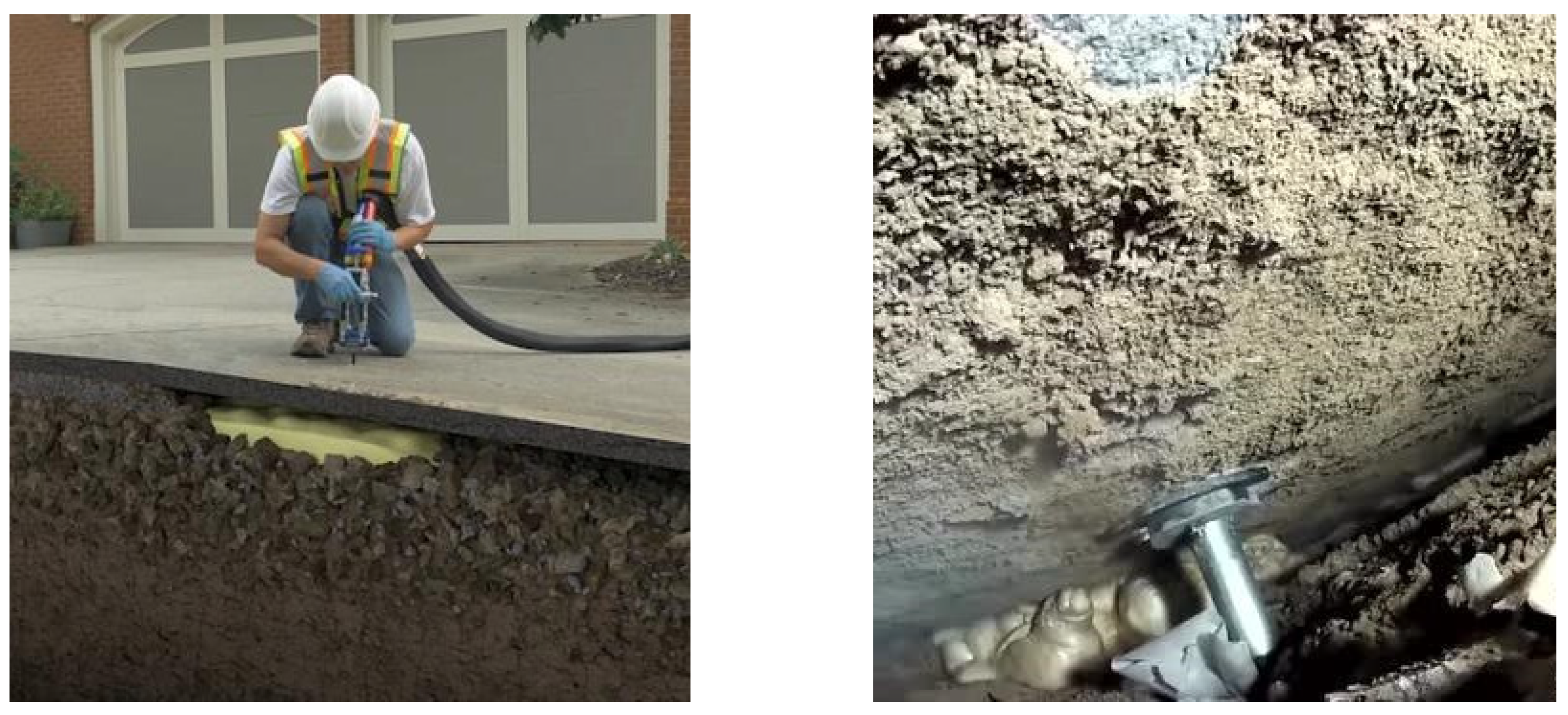


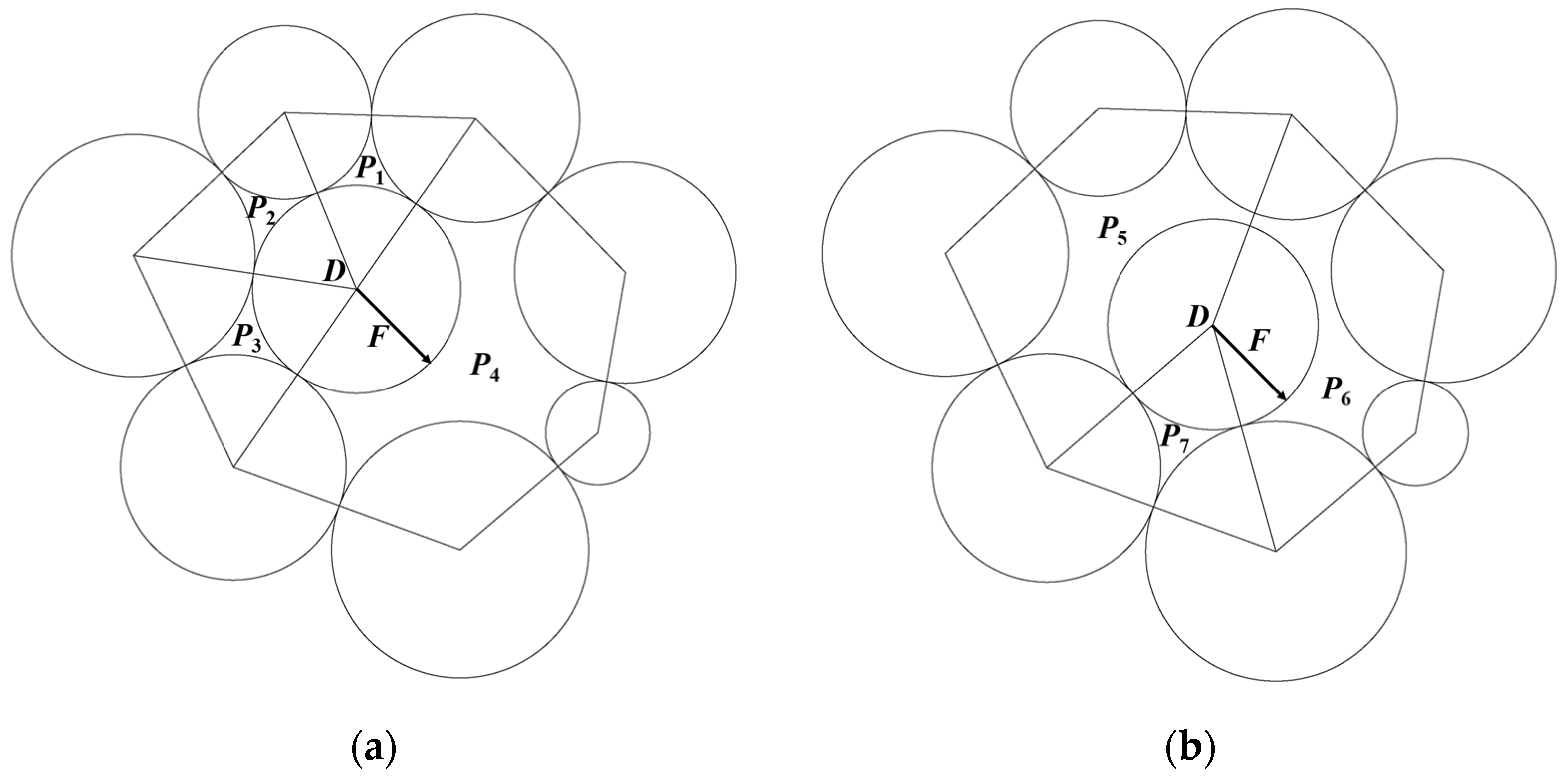
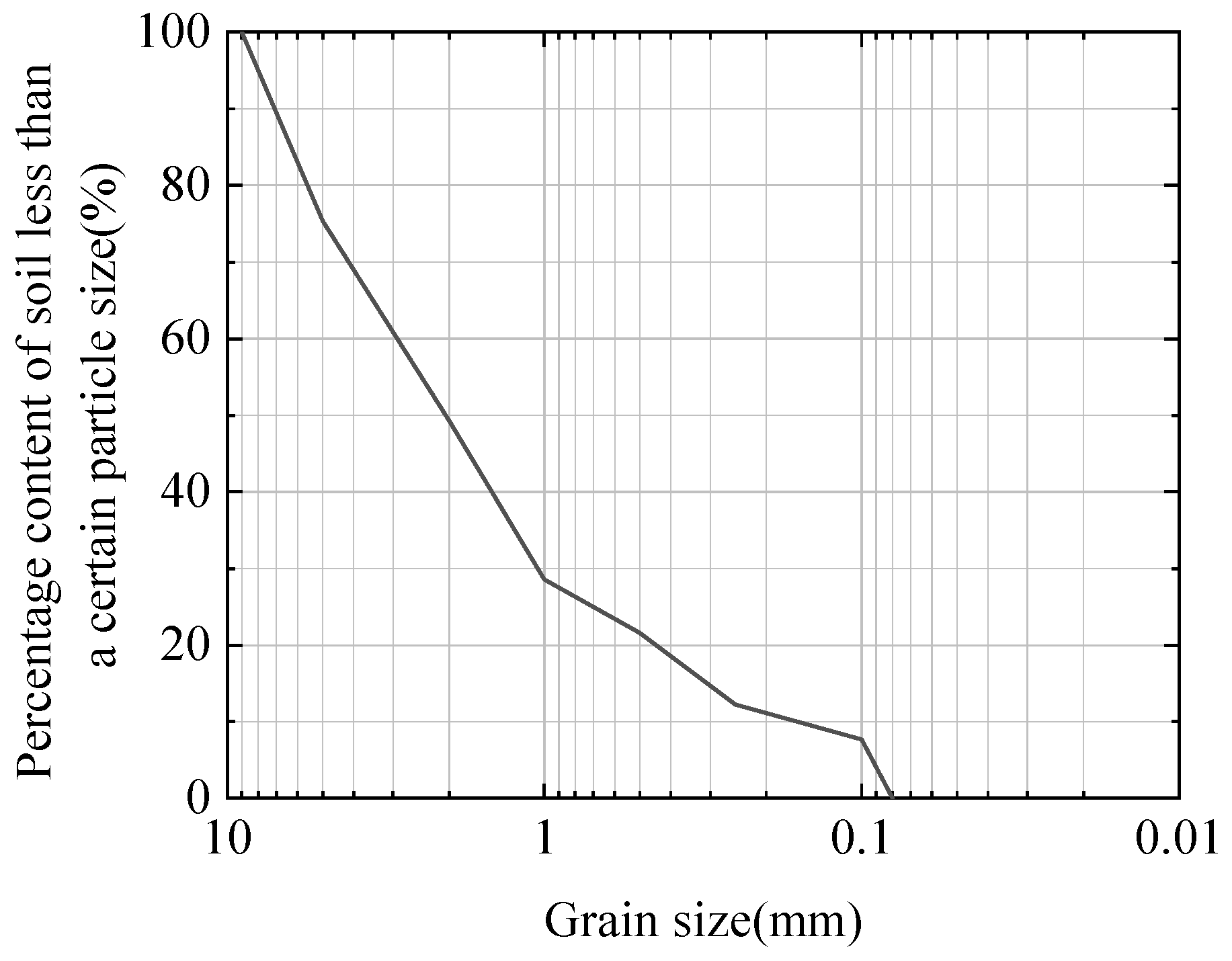

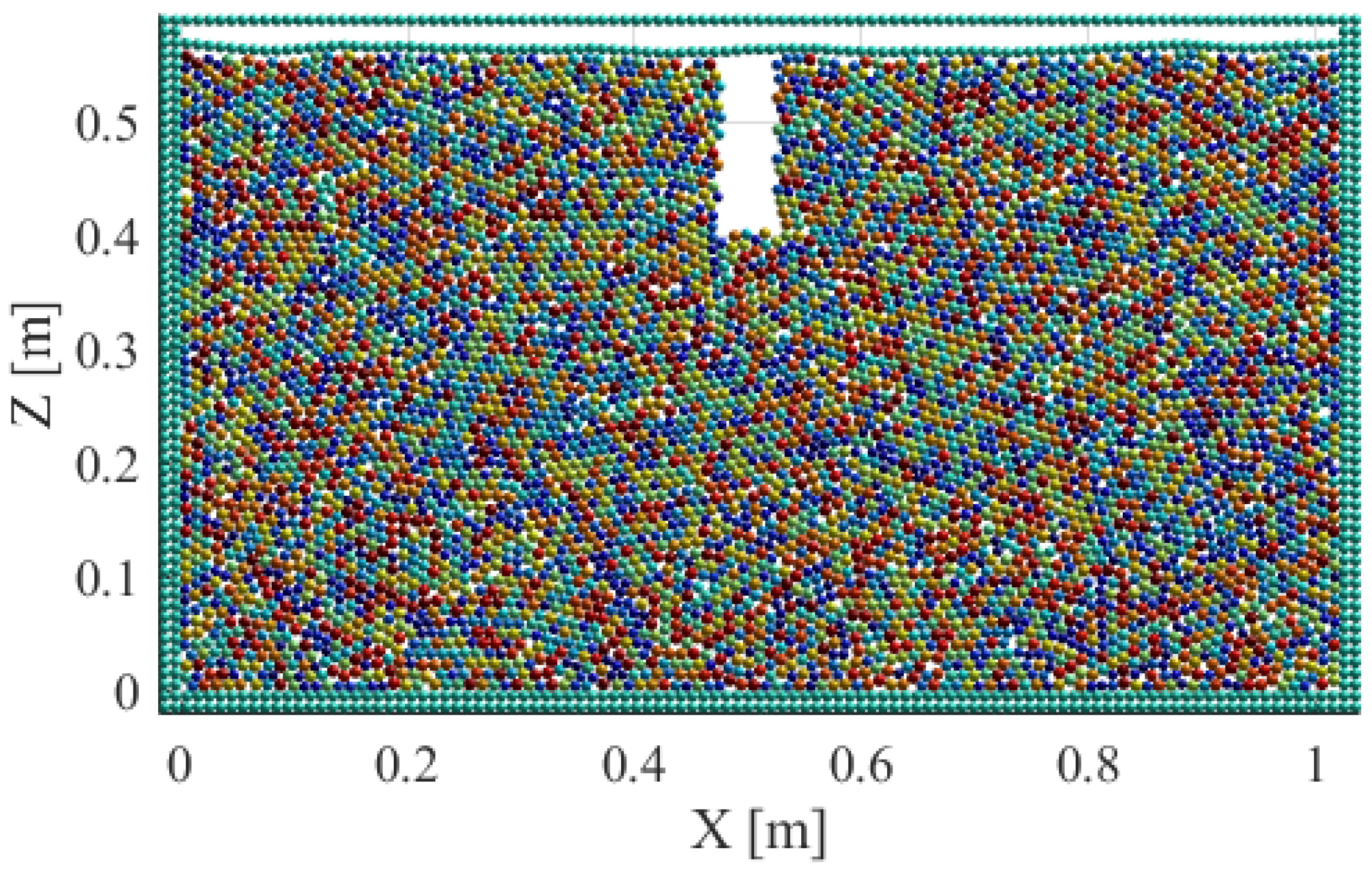

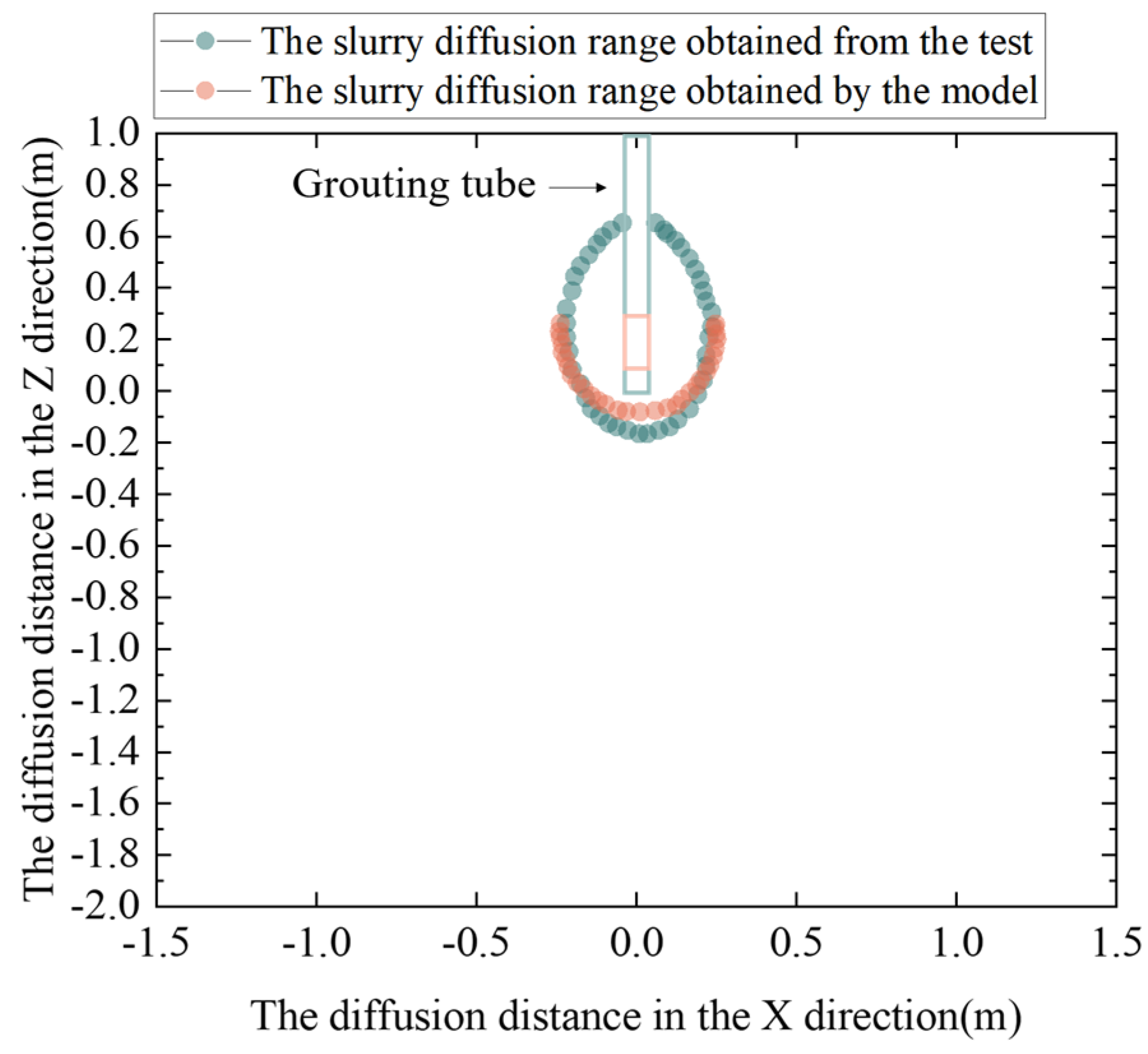
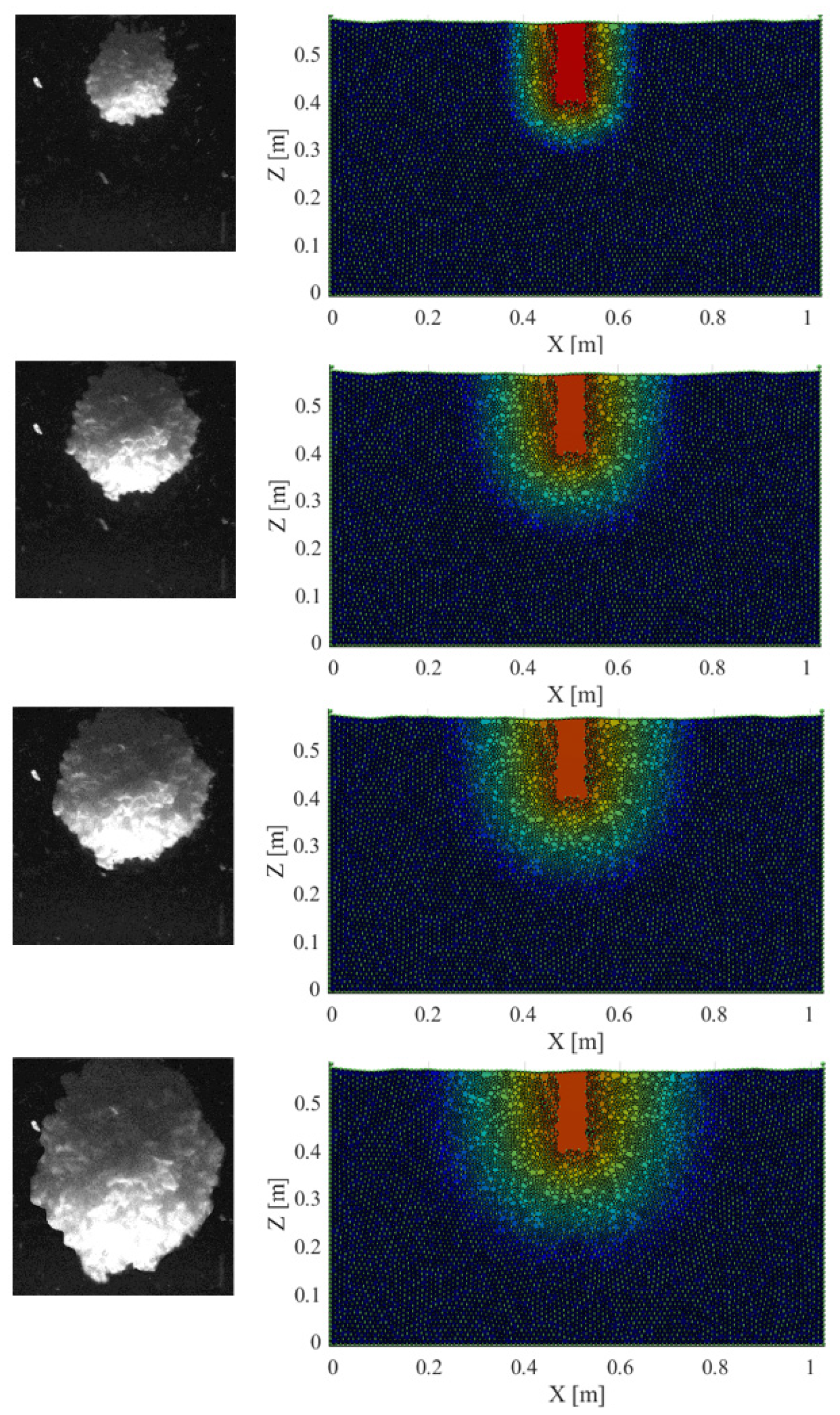


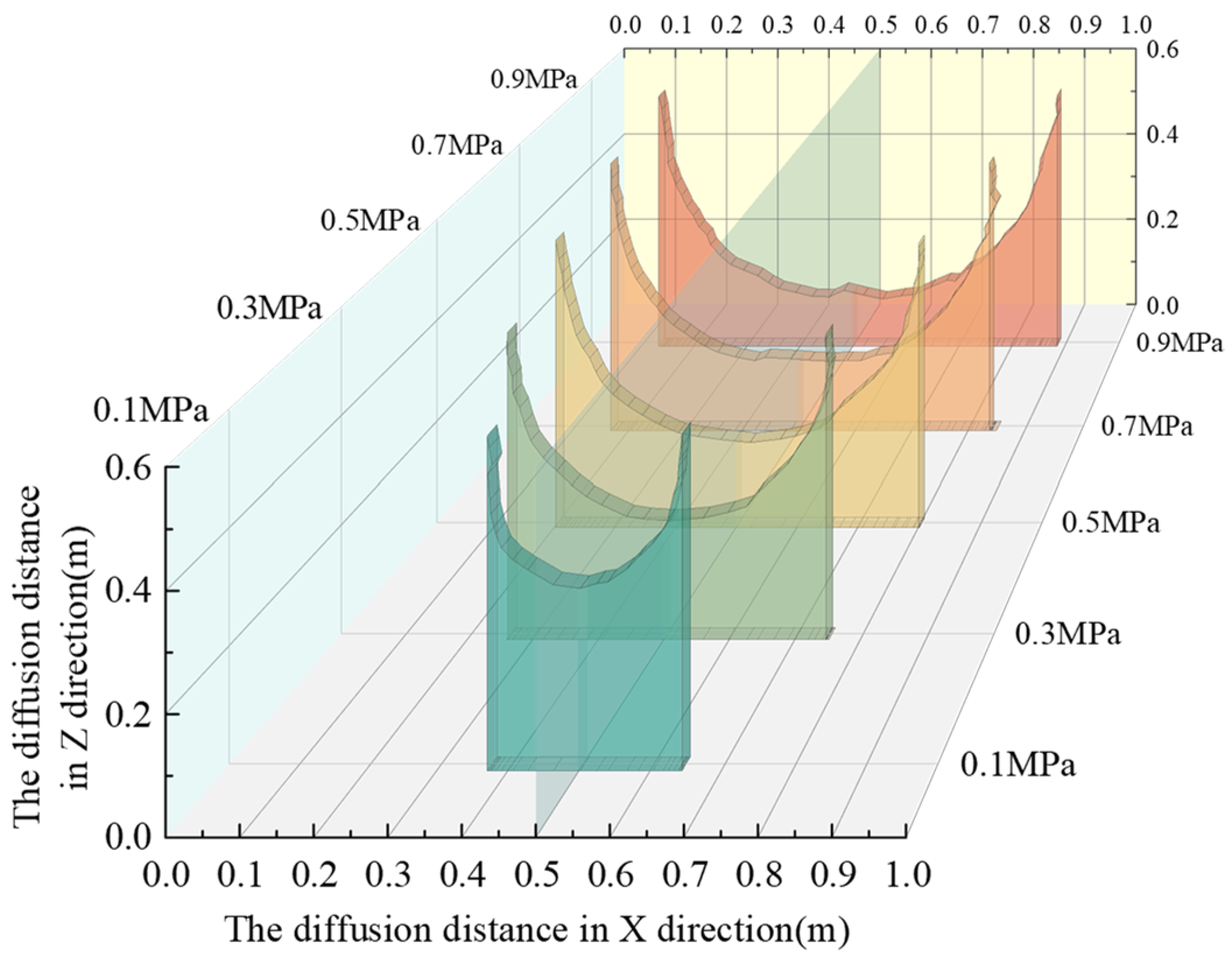
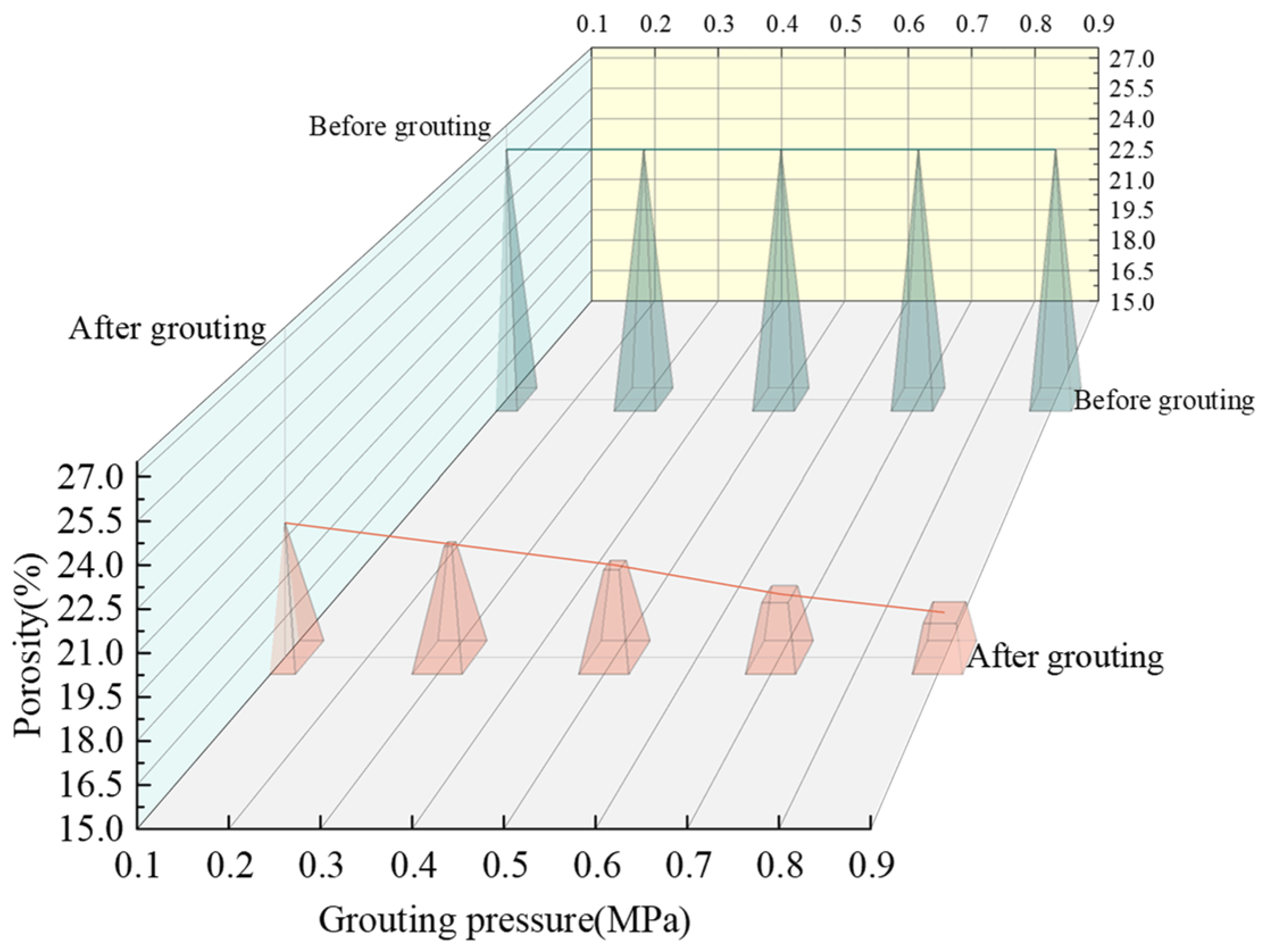
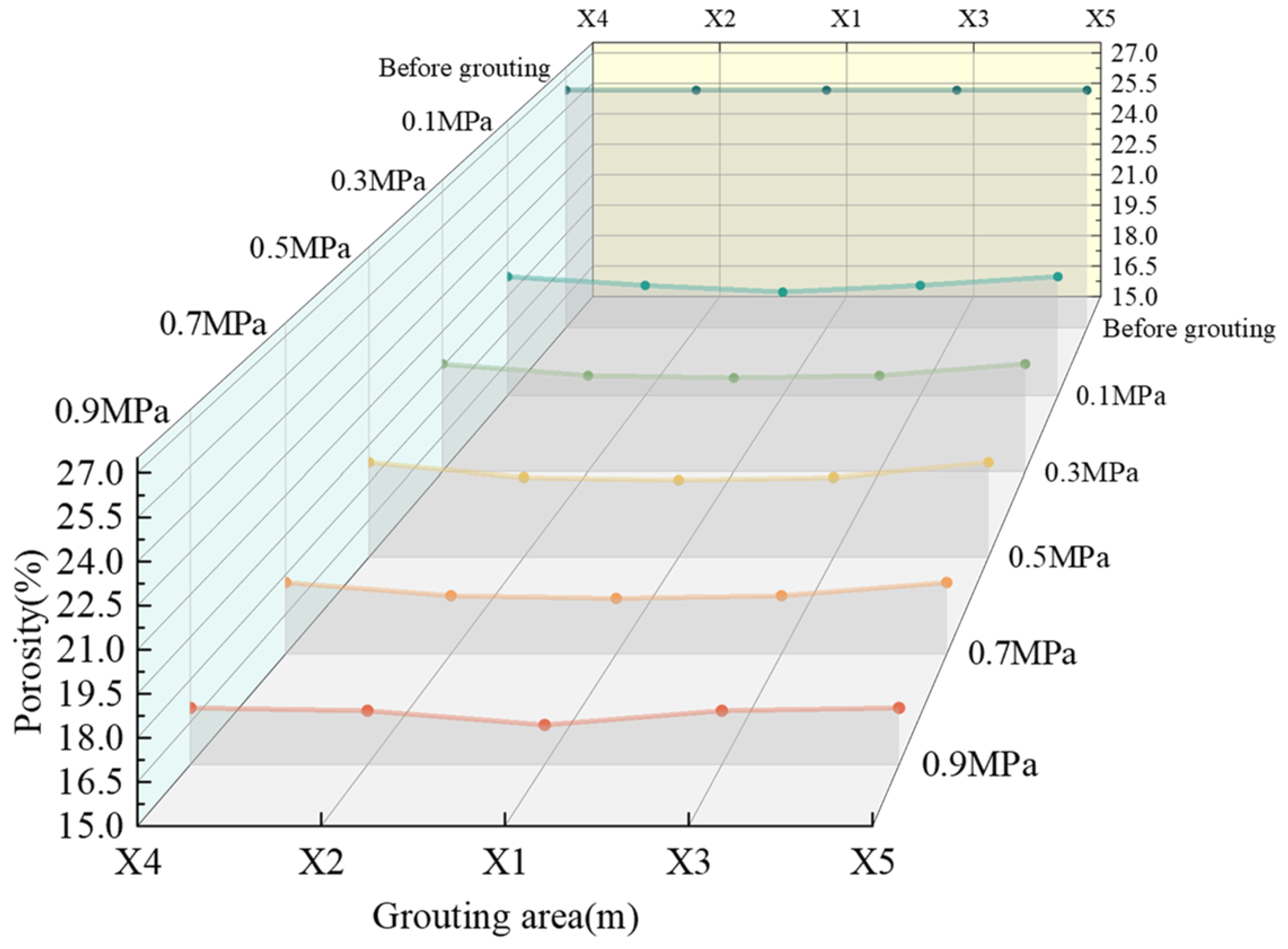
| Macromechanical Properties of Materials | Micromechanical Parameters of Materials | ||
|---|---|---|---|
| Rock Mass | Numerical Value | Rock Mass | Numerical Value |
| Young’s modulus (E/Pa) | 6.3 × 1010 | Positive stiffness (Kn/N·m−1) | 1.2 × 108 |
| Poisson’s ratio (v) | 0.34 | Tangential stiffness (Ks/N·m−1) | 9.6 × 107 |
| Internal friction coefficient (μ) | 1.469 | Friction coefficient (μp) | 0.5 |
| Density (ρ/kg·m−3) | 2600 | Damping coefficient | 0.1 |
| Experimentation | Specimen Height (H/cm) | Specimen Diameter (D/cm) | Coefficient of Uniformity (Cu) | Coefficient of Curvature (Cc) | Axial Strain Loading Rate (ε/mm·min−1) |
|---|---|---|---|---|---|
| Indoor static triaxial test | 20 | 10 | 21.94 | 2.53 | 0.6 |
| Experimentation | Slurry Density (ρc/kg·m−3) | Slurry Viscosity (μc/Pa·s) | Maximum Grouting Pressure (Fm/MPa) | Length of Grouting pipe (L/mm) | Grouting Pipe Inner Diameter (d/mm) |
|---|---|---|---|---|---|
| Indoor polymer grouting test | 1500 | 0.02 | 0.8 | 6 | 4 |
| Grouting Pressure (MPa) | Variations in the X Direction | Variations in the Z Direction | ||||
|---|---|---|---|---|---|---|
| Before Grouting (Pa) | After Grouting (Pa) | Increase Amplitude (%) | Before Grouting (Pa) | After Grouting (Pa) | Increase Amplitude (%) | |
| 0.1 | −218,150 | −225,610 | 3.42 | −238,390 | −247,300 | 3.73 |
| 0.3 | −218,150 | −231,020 | 5.90 | −238,390 | −254,340 | 6.69 |
| 0.5 | −218,150 | −236,690 | 8.50 | −238,390 | −260,500 | 9.27 |
| 0.7 | −218,150 | −241,020 | 10.48 | −238,390 | −264,340 | 10.89 |
| 0.9 | −218,150 | −245,610 | 12.59 | −238,390 | −267,300 | 12.13 |
Disclaimer/Publisher’s Note: The statements, opinions and data contained in all publications are solely those of the individual author(s) and contributor(s) and not of MDPI and/or the editor(s). MDPI and/or the editor(s) disclaim responsibility for any injury to people or property resulting from any ideas, methods, instructions or products referred to in the content. |
© 2025 by the authors. Licensee MDPI, Basel, Switzerland. This article is an open access article distributed under the terms and conditions of the Creative Commons Attribution (CC BY) license (https://creativecommons.org/licenses/by/4.0/).
Share and Cite
Lv, Y.; Wang, J.; Li, H.; Zhu, J. Research on Grouting Pressure of Earth–Rock Dams Reinforced by Polymer Based on Discrete Elements. Appl. Sci. 2025, 15, 1574. https://doi.org/10.3390/app15031574
Lv Y, Wang J, Li H, Zhu J. Research on Grouting Pressure of Earth–Rock Dams Reinforced by Polymer Based on Discrete Elements. Applied Sciences. 2025; 15(3):1574. https://doi.org/10.3390/app15031574
Chicago/Turabian StyleLv, Yanyuan, Jianxin Wang, Hongmei Li, and Jianing Zhu. 2025. "Research on Grouting Pressure of Earth–Rock Dams Reinforced by Polymer Based on Discrete Elements" Applied Sciences 15, no. 3: 1574. https://doi.org/10.3390/app15031574
APA StyleLv, Y., Wang, J., Li, H., & Zhu, J. (2025). Research on Grouting Pressure of Earth–Rock Dams Reinforced by Polymer Based on Discrete Elements. Applied Sciences, 15(3), 1574. https://doi.org/10.3390/app15031574






